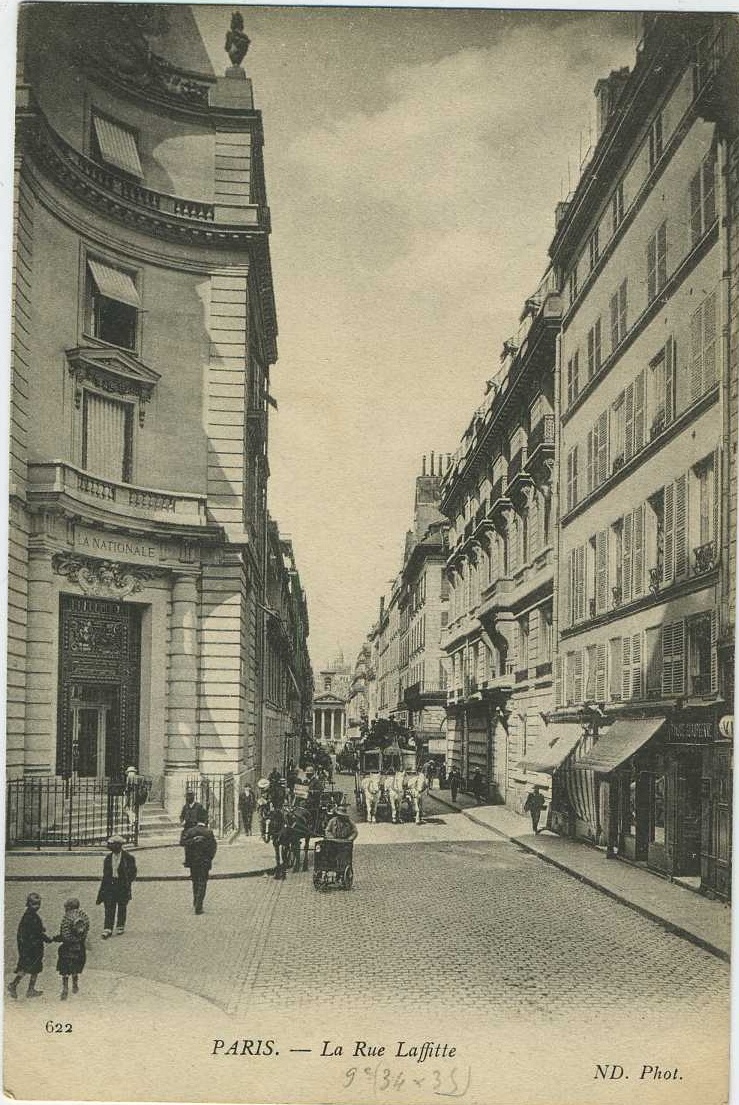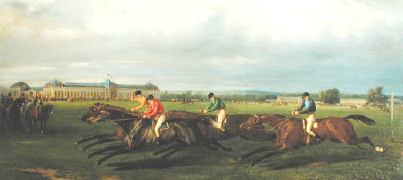Though the exact circumstances of John Howlett's arrival in France are still to be found, this page will provide you with elements of historical context.

Some 25 years after the institution of the English Classic races, Napoleon issued an Imperial Decree on 13 Fructidor XII, (by his republican calendar, or 31st August 1805) commanding the establishment of races at the seven horse breeding centres throughout the French Empire. This however, did little to raise the standards of French racing, as the French preferred heavy saddle horses and central French bureaucratic control appears to have delayed the development of the sport in France.
It was not until the 1820s when, under the leadership of an eccentric English milord, Lord Henry Seymour (1805-1859), the basis of modern horse racing was established on the English model. He was to be aided by the migration of several important English training families, such as the Carters, Cunningtons, Jennings and Watsons, who were to dominate French racing for over 100 years.
Seymour, who was so influential in the establishment of modern French racing, was born in Paris and never lived in England. He was the eccentric second son of the Marquis of Hertford with a French mother, Maria Fagniani, who was in receipt of a fortune left by two members of the English Jockey Club, George Selwyn and Lord Queensbury (referred to as "Q"), who believed she had a "daughter's claim" on them. He never married, and was a rather crude practitioner of practical jokes.

In about 1825, at the Rue Blanche in Paris, the Englishman Thomas Bryon, established an English Jockey Club (and Pigeon Shooting Club). It had 18 members, of whom four were English, including Seymour. In 1833 they founded two associations; The Jockey Club and (less succinctly) the Societe d Encouragement pour l Amelioration des Races de Chevaux en France.
Seymour was the first President of the Jockey Club and Societe and the group included two royal dukes (Duc d Orleans and Duc de Nemours). Ferdinand d Orleans, Duc d Orleans, (1810-1842) was the eldest son of King Louis Philippe.
The Jockey Club ran matches against each other in the Parisian Bois de Boulogne, which, by 1833, became established races of the Societe d Encouragement, using imported thoroughbreds. A Grand Prix was run on the Champ de Mars (future site of the Eiffel Tower) in 1834 and won by Felix (by imported Rainbow) but horses in Paris at that time were trained on the roads of the Bois, which were either baked hard in the sun or awash with mud. From then on virtually all thoroughbred training activity moved to Chantilly (north of Paris).
In 1836 Seymour came to Chantilly and entered three of the 10 horses for the first running of the Prix du Jockey Club, the French Derby, and won with Franck (by Rainbow). The 1836 meeting was a great success among the dandified upper class crowd despite the inclement weather, which soaked the pretty ladies. The following year, in 1837, the first handicap was run at Chantilly on the Prix du Jockey Club day, again won by Seymour.
In 1838 the banker Charles Laffitte, treasurer of the Jockey Club, became director at Chantilly and greatly improved the course and facilities. The meeting became "fete-champetre," a rather smart country fair and feast, which was the obligatory end to the Paris season.
In 1842 Seymour suddenly gave up the sport and the Duc d Orleans had a fatal coaching accident. The racing at Chantilly was for a long time no longer "fete-champetre." French racing would need the establishment of Longchamp to energise it and turn it from a marginal aristocratic sport to a vigorous popular recreation. It needed income from mass support and the establishment of organised gambling.
Seymour's love child Richard Wallace (born in London in 1818 to Agnes Jackson nee Wallace - a descendant of scottish resistant William Wallace) had been raised in France by the Marquise of Hertford as his grandson. As an adult he worked as assistant and business advisor to his father.
On his death Seymour left his fortune to four of his horses (on condition that they never ran again) and several Paris hospitals, having no official heir.
From 1853, John Howlett became first coachman to Mr. Charles Spencer Cowper (1818 - 1879), his son Edwin jointly entered his staff as second coachman. Mr. Spencer Cowper was also from Norfolk and was newly married to Countess d Orsay (Lady Harriet Gardiner 1814-1869), the widow of fashionable French artist and dandy Count Alfred d Orsay.
Though he had been deprived from most of his father's inheritance, Richard Wallace became famous during the siege of Paris in the 1870's as he financed a military ambulance, and had a hospital built in Levallois Perret, in the near outskirts of Paris.In 1872 he had a hundred of drinking water fountains built in Paris.
Source: http://www.tbheritage.com/TurfHallmarks/Trainers/Fr/LesAnglais.html
Some 25 years after the institution of the English Classic races, Napoleon issued an Imperial Decree on 13 Fructidor XII, (by his republican calendar, or 31st August 1805) commanding the establishment of races at the seven horse breeding centres throughout the French Empire. This however, did little to raise the standards of French racing, as the French preferred heavy saddle horses and central French bureaucratic control appears to have delayed the development of the sport in France.
It was not until the 1820s when, under the leadership of an eccentric English milord, Lord Henry Seymour (1805-1859), the basis of modern horse racing was established on the English model. He was to be aided by the migration of several important English training families, such as the Carters, Cunningtons, Jennings and Watsons, who were to dominate French racing for over 100 years.
Seymour, who was so influential in the establishment of modern French racing, was born in Paris and never lived in England. He was the eccentric second son of the Marquis of Hertford with a French mother, Maria Fagniani, who was in receipt of a fortune left by two members of the English Jockey Club, George Selwyn and Lord Queensbury (referred to as "Q"), who believed she had a "daughter's claim" on them. He never married, and was a rather crude practitioner of practical jokes.

In about 1825, at the Rue Blanche in Paris, the Englishman Thomas Bryon, established an English Jockey Club (and Pigeon Shooting Club). It had 18 members, of whom four were English, including Seymour. In 1833 they founded two associations; The Jockey Club and (less succinctly) the Societe d Encouragement pour l Amelioration des Races de Chevaux en France.
Seymour was the first President of the Jockey Club and Societe and the group included two royal dukes (Duc d Orleans and Duc de Nemours). Ferdinand d Orleans, Duc d Orleans, (1810-1842) was the eldest son of King Louis Philippe.
The Jockey Club ran matches against each other in the Parisian Bois de Boulogne, which, by 1833, became established races of the Societe d Encouragement, using imported thoroughbreds. A Grand Prix was run on the Champ de Mars (future site of the Eiffel Tower) in 1834 and won by Felix (by imported Rainbow) but horses in Paris at that time were trained on the roads of the Bois, which were either baked hard in the sun or awash with mud. From then on virtually all thoroughbred training activity moved to Chantilly (north of Paris).
In 1836 Seymour came to Chantilly and entered three of the 10 horses for the first running of the Prix du Jockey Club, the French Derby, and won with Franck (by Rainbow). The 1836 meeting was a great success among the dandified upper class crowd despite the inclement weather, which soaked the pretty ladies. The following year, in 1837, the first handicap was run at Chantilly on the Prix du Jockey Club day, again won by Seymour.
In 1838 the banker Charles Laffitte, treasurer of the Jockey Club, became director at Chantilly and greatly improved the course and facilities. The meeting became "fete-champetre," a rather smart country fair and feast, which was the obligatory end to the Paris season.
In 1842 Seymour suddenly gave up the sport and the Duc d Orleans had a fatal coaching accident. The racing at Chantilly was for a long time no longer "fete-champetre." French racing would need the establishment of Longchamp to energise it and turn it from a marginal aristocratic sport to a vigorous popular recreation. It needed income from mass support and the establishment of organised gambling.
Seymour's love child Richard Wallace (born in London in 1818 to Agnes Jackson nee Wallace - a descendant of scottish resistant William Wallace) had been raised in France by the Marquise of Hertford as his grandson. As an adult he worked as assistant and business advisor to his father.
On his death Seymour left his fortune to four of his horses (on condition that they never ran again) and several Paris hospitals, having no official heir.
From 1853, John Howlett became first coachman to Mr. Charles Spencer Cowper (1818 - 1879), his son Edwin jointly entered his staff as second coachman. Mr. Spencer Cowper was also from Norfolk and was newly married to Countess d Orsay (Lady Harriet Gardiner 1814-1869), the widow of fashionable French artist and dandy Count Alfred d Orsay.
Though he had been deprived from most of his father's inheritance, Richard Wallace became famous during the siege of Paris in the 1870's as he financed a military ambulance, and had a hospital built in Levallois Perret, in the near outskirts of Paris.In 1872 he had a hundred of drinking water fountains built in Paris.
Source: http://www.tbheritage.com/TurfHallmarks/Trainers/Fr/LesAnglais.html